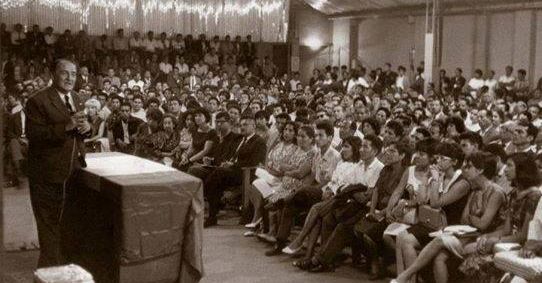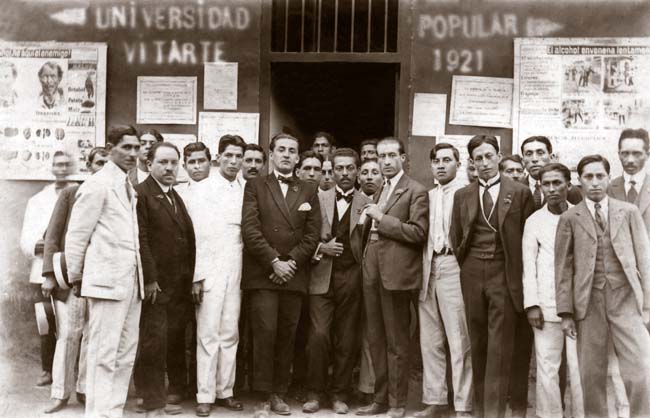|
By Jack
Englehardt
A Lenin for the Americas: Víctor Raúl Haya de la Torre and the Forgotten
Story of Indigenous Revolutionary Socialism
The geist of early nineteenth century Latin America was one of a world
in motion, marked by mounting political unrest and profound social
dislocation. This was a time of ideological innovation, when radical
solutions rose to meet age-old anxieties over poverty, inequity, and
oppression. No better case exists to illustrate this transnational
junction in history than the Alianza Popular
Revolucionaria Americana (APRA) – the first truly continent-wide
movement to cast off the shackles of Latin America’s colonial past. The apristas, guided for nearly sixty years by the messianic personality
of Víctor Raúl Haya de la Torre, were visionary not just in their
radical politics, but in their cultivation of a distinctly American
identity through broad networks of exile and agitation. In recounting
the personal exodus of Haya de la Torre, this essay will situate APRA
within the Pan-American heritage of Simón Bolívar and José Marti, and
draw long-denied attention to its role in forming a truly popular
‘continental consciousness’.

From a young age, Haya de
la Torre was sharply aware of the shortcomings of capitalism in his
native Peru. Raised in the coastal town of Trujillo, he had witnessed
the dramatic expansion of foreign-owned sugarcane enterprises in the
early years of the twentieth century, and the ensuing displacement of
local farmers and businessmen. In his college years, Haya de la Torre
encountered the philosophy of José Carlos Mariátegui,
whose indigenismo became one of APRA’s ideological trademarks. In his 7 Ensayos, Mariátegui had written that the Andean society of the Inca,
with its communal ayllu system of agriculture, was inherently socialist, and thus a
viable historical model to the Eurocentric models promoted by Marxist
orthodoxy. It was, therefore, with a clear ideological precedent that
Haya de la Torre organized the Peru’s first ‘popular universities’ as a
student leader in 1921, bringing together workers and students through
extension courses on union organization and Inca civilization. Haya de
la Torre understood that none of the grand western ideologies then in
vogue – Italian fascism, Russian communism, American liberal capitalism
– were an adequate political formula for Latin America. Steeped in the indigenismo of Mariátegui, he viewed contemporary problems as rooted in a
legacy of foreign-imposed models of society, economy, and governance. If
native problems necessarily demanded native solutions, only committed
hemispheric unity could build a policlasista coalition of peasants, intellectuals, and the middle classes
behind the banner of Latin American salvation. From this point forward,
opposition to ‘Yankee imperialism’ would be the raison d’être for APRA’s popular revolution.
Haya de la Torre, whose activism had landed
him in prison, eventually worn out his welcome with the government of
dictator Augusto Leguía, and was exiled from Peru in 1923. Frail from a
hunger strike and virtually unknown outside of his home country, he
boarded the German freighter Negada and made his way to Mexico. There, he would find refuge in
the reformist administration of Álvaro Obregón, whose education ministry
hired Haya de la Torre as an editor and liaison for the Mexican
Federation of University Students. At a 1924 meeting of the Federation,
Haya de la Torre unveiled a red and gold banner depicting a ‘United
States of Indo-America’ from the Rio Grande to its Patagonian fringe.
APRA had effectively been born, though its official ‘five-point’
platform of Indo-American political unity, action against imperialism,
nationalization of land and industry, internationalization of the Panama
Canal, and solidarity with the oppressed would come some time later. In
Mexico – site of the first great social revolution of the twentieth
century – Haya de la Torre would mingle with the likes of Diego Rivera
and Gabriela Mistral, ingratiating himself with Latin America’s
tastemakers and building a powerful audience for his lifelong project of
hemispheric unity.

From Mexico, the exiled aprista traveled to Russia, where he studied the recent revolution
and sharpened his resolve that scientific Marxism would be an inadequate
tonic for a region whose proletariat had no class consciousness and
remained in a state of pre-colonial feudalism. In Germany, he met with
Albert Einstein, whose theory of relativity was used to argue that Latin
America inhabited a unique space (environment) and time (stage of
development) not captured in conventional theories. The philosophies of
Marx, Hegel, and Kant belonged to the antiquated realm of Newtonian
physics; APRA spoke for a future grounded in Einsteinian relativity. In
England, Haya de la Torre took courses at Oxford and mingled with a
constellation of European émigrés. In France, he presided over the first
purely aprista meeting, where he denounced the ongoing United States
intervention in Nicaragua. In Brussels, he served as a Latin American
delegate to the International Congress against Colonial Oppression and
Imperialism, before a rising international profile called him back to
service in his native hemisphere.
Emboldened by the accolades of a captive European public, Haya de la
Torre set off on a grand publicity tour through Central America in 1927,
aiming to eventually link up with the revolutionary forces of Augusto
César Sandino in Nicaragua. From Quetzaltenango in Guatemala to Santa
Ana in El Salvador, Haya de la Torre was fêted by students and leftist
groups, who formed new APRA national secretariats in his wake. The
Peruvian’s oratorical skill and resonant message drew more than just
adoring crowds, however, as anxious Central American governments began
to take stock of the new insurgent ideology. In a dramatic standoff with
the police in San Salvador, the timely intervention of Mexican diplomats
was all that saved Haya de la Torre from court-martial and a likely
sentence of death. The United States government, too, recognized the
threat posed by APRA to its regional interests, and intervened directly
to prevent Haya de la Torre from reaching a critical mass of public
support. When the young agitator attempted to disembark from the ocean
liner Phonecia in Panama, the US Canal Zone authorities refused him entry,
quite literally shanghaiing him back into exile at the vessel’s next
port of call in Bremen. Yet the damage had already been done – Haya de
la Torre’s Middle American excursion received widespread coverage in the
Latin American press, and inspired the passions of anti-imperialist
colleagues who forcefully came to the Peruvian’s defense.

By the 1930s, APRA’s message of socialist revolution on American terms
seemed more popular than ever. Haya de la Torre, described by a
contemporary as “the most striking, picturesque, and exuberant
personality in all Latin America,” had woven a scattered network of
intellectuals into a pointed political movement with a strong grassroots
support. APRA cells were established in cities as distant as Santiago
(which boasted nearly a hundred émigrés) and Paris (whose modest aprista contingent was said to fit entirely on one sofa). Exponents of
revolution like the poet Magda Portal – then the highest-ranked female
political leader on the continent – captivated thousands in public
addresses. Legendary journals, like Mariátegui’s Amauta (a Quechua term meaning ‘wise one’), disseminated APRA texts
throughout the hemisphere. The transnational dimension of the aprismo ideology in this critical foundational periodcannot be
emphasized enough – indeed, it was not until the fortuitous overthrow of
Leguía’s regime in 1930 that APRA could legally return to its spiritual
homeland.
Even though the movement had been outlawed for the better part of a
decade, it proved to have a powerful hold on the disenfranchised
Peruvian lower classes. The exiled Haya de la Torre was an instant
contender for the presidency, and his celebrated repatriation became a
generational spectacle. He was greeted by a mass-meeting at the Lima
Hippodrome, attended by at least twenty thousand long-suffering
countrymen. Though the Peruvian Aprista Party would narrowly lose the
1931 election to the conservative coalition of Luis Miguel Sánchez
Cerro, it had already opened the floodgates for radical participation in
the democratic process. Sánchez Cerro was so fearful of the common man’s
allegiance to aprismo that he ordered the rifles of rank-and-file soldiers to be
taken away at night, even at the frontline of the ongoing border war
with Colombia. Locked in a bitter test of strength with the government,
APRA was outlawed after a few short years, with its members persecuted
and its leadership once again driven into exile. This period of intense
suppression would force the movement underground until 1945, but it
would fail to dilute the potency of aprismo’s distinctly Indo-American revolutionary doctrine. Just as it
had under the Leguía regime, APRA flourished in exile, marketing itself
as the philosophical vanguard of an increasingly agitated Latin American
body politic.
For the remainder of the twentieth century, APRA would battle
accusations from both political extremes that it was insufficiently
radical – fascists viewed its anti-imperial streak with disdain, while
communists criticized the movement’s toleration of capitalism and
private property. The true innovation of aprismo ideology, then, lies not in its relation to Western
doctrinaire philosophy, but the telling precedent that a positive Latin
American identity could only rise from indigenous thought and popular
action. With its Quechua songs and cheers, and cells named after Inca
emperors, APRA vindicated a shunned pre-colonial past and became the
first popular movement to call for the wholesale liberation of Indians,
who for over four centuries had been political non-participants. APRA’s
ambition to create a “maximum program” of sister cells spread throughout
the Indo-American continent did not survive the ferment of the twentieth
century, but it did lay the theoretical foundation for an impressive
lineage of revolutionary discourse, affirming the diversity and power of
the Latin American voice.
It was not until 1985 that the Peruvian Aprista Party – most durable of
all APRA national secretariats – would finally come to power under the
leadership of Alan García. The prophetic Víctor Raúl Haya de la Torre
did not live to see his project actualized – he died in 1979, still at
the helm of the movement – but his stewardship of the Latin American
left through a tumultuous century would reap dividends. Now forgotten to
many outside of Peru, Haya de la Torre was, for sixty years, the
emeritus philosopher of the whole Latin American revolution. His
remarkable experiment in native radicalism matched and surpassed the
political vision of the greatest émigré statesmen of his day, and
deserves to be held to the same far-sighted standard as Lenin, Trotsky,
and Marx.
The views expressed in this article are the author’s own, and may not
reflect the opinions of the St Andrews Economist.
References
Ameringer, Charles D. The
Socialist Impulse: Latin America in the Twentieth Century.
Gainesville: University Press of Florida, 2009.
Beals, Carleton. “Aprismo:
The Rise of Haya de la Torre.” Foreign
Affairs 13, no. 2 (1935): 236-246.
García-Bryce, Iñigo.
“Transnational Activist: Magda Portal and the American Popular
Revolutionary Alliance (APRA), 1926-1950.” The
Americas 70, no. 4 (April 2014): 677-706.
Masterson, Daniel.
“Changing focus of Aprismo: Haya de la Torre, Alan Garcia and the
Anti-Imperialist Tradition in Peru.” Journal
of Third World Studies 7, no. 2 (Fall 1990): 89-114.
Salisbury, Richard V. “The
Middle American Exile of Víctor Raúl Haya de la Torre.” The
Americas 40, no. 1 (July
1983): 1-15.
https://standrewseconomist.com/2021/01/04/a-lenin-for-the-americas-raul-haya-de-la-torre-and-the-forgotten-story-of-indigenous-revolutionary-socialism/
|